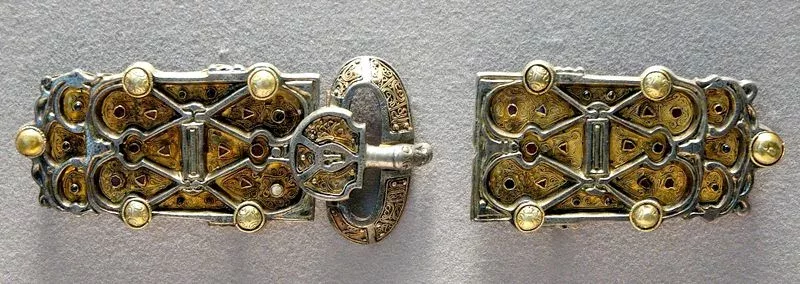When we think to barbaric population we do not realize that even such people were able to develop art forms but, as we know,art is inextricably linked to mankind therefore each population,even the one apparently rough, managed to create peculiar art forms. The so-called barbaric art developed between Late Antiquity and Early Middle Ages which means between 5th and 9th century and it was born during the period of barbaric invasions that decreed the end of Western Roman Empire.The geographic zone in which developed this particular kind o art is rather wide and it goes from Danube to Iberian Penisula,from Scandinavia to British Isles until to push iteself to North Africa.
This kind of art derives from art of Asian nomads as evidenced by several archaeological discoveries in Siberia and Russia. The condition of nomadism had to create a type of art easy to carry due to constant travel of such people therefore the art of processing of the most disparate objects was prepared to create an ornamental art. Over the time barbarian kingdoms produced forms of architecture,sculpture and painting but at the beginnig these three art were the result mostly to the mastery of conquered peoples. Neverthless barbarian people managed to create their own kind of peculiar art both architecture and sculpture even though nothing remain about architecture ,beside some description in different poems ,since it was built of wood. However sculpture produced most of all stone funeral stele which represented Nordic sagas,wooden ships from which sprouted monster heads and ornamental bands that later will inspire to the art of goldsmithing which became the artistic field most prolific of all barbaric art.
Barbaric art influenced European art of the following centuries probably due to its nature typically abstract indeed it was common in all barbaric art turn natural elements into simple decorative deformations which sometimes became pure geometrical elements. Afterwards such elements were applied to sculptures,mosaics,jewerly and even weapons. In several grave goods in the centre of Italy,have been discovered fibulae,belonged to barbarian people,in which we can notice decorations of stylized animals broken down and repeated symmetrically. Such strong abstract conception was an absolute novelty in italian art but probably in all european art so much that we can dare to affirm that barbaric art has anticipated by several centuries abstract twentieth century painting,not so bad for people considered crude and violent in the popular immagination.
Undoubtedly the art of goldsmithing was the artistic field in which barbaric art produced the highest level by creating fibulae,diadems,hilts and clasps of belt. Furthermore barbaric art can be divided into two styles: the polychrome style and the animalistic one.

Polychrome style dates back to the time of Huns and it is characterized by using of polished stones embedded in gold as garnet and almandine. Such processing technique became widespread both in Italy and Spain and it reached its peak at the age of Childeric I. It was a technique which had a great success and long-lived since it was used untill 7th century both by Franks and Longobards.
On the other hand animalistic style is characterized by geometric figures which cover all surface of artefacts like buckels,crowns,crosses and various seals. Many art historians tend to spit further such style in two subdivisions. The first animalistic style is characterized by broken down an asymmetrical elements in which animal shapes are realistic and essential and we can often notice human figures and regular geometric themes. However the second style shows a more regular and smooth design as well as byzantine influences whereas animal shapes are more stylized and hardly recognizable. According to some art historians such abstraction could have been due to the urge to mask pagan myths in order to protect them from new Christian religion which was spreading all over Europe and not only.
Conclusions
Barbaric art has been a kind of art which bound together different people and it stood out for an amazing modernity compared to the time in which it has been made. Its strong abstraction and its vivid and brilliant colours give it still today a timeless charm which influenced all European art that developed in following centuries. We can also dare to affirm that barbaric art was ahead of its time with its characterized stylized shapes more or less complex as those of animals,in most cases,but rarely even human figures and vegetable elements used mostly for decorative and ornamental purposes. In fact the great insight and innovation of barbaric art was that to simplify real and complex figures in order to turn them into geometric and ornamental elements not always harmonic but rather powerful.
